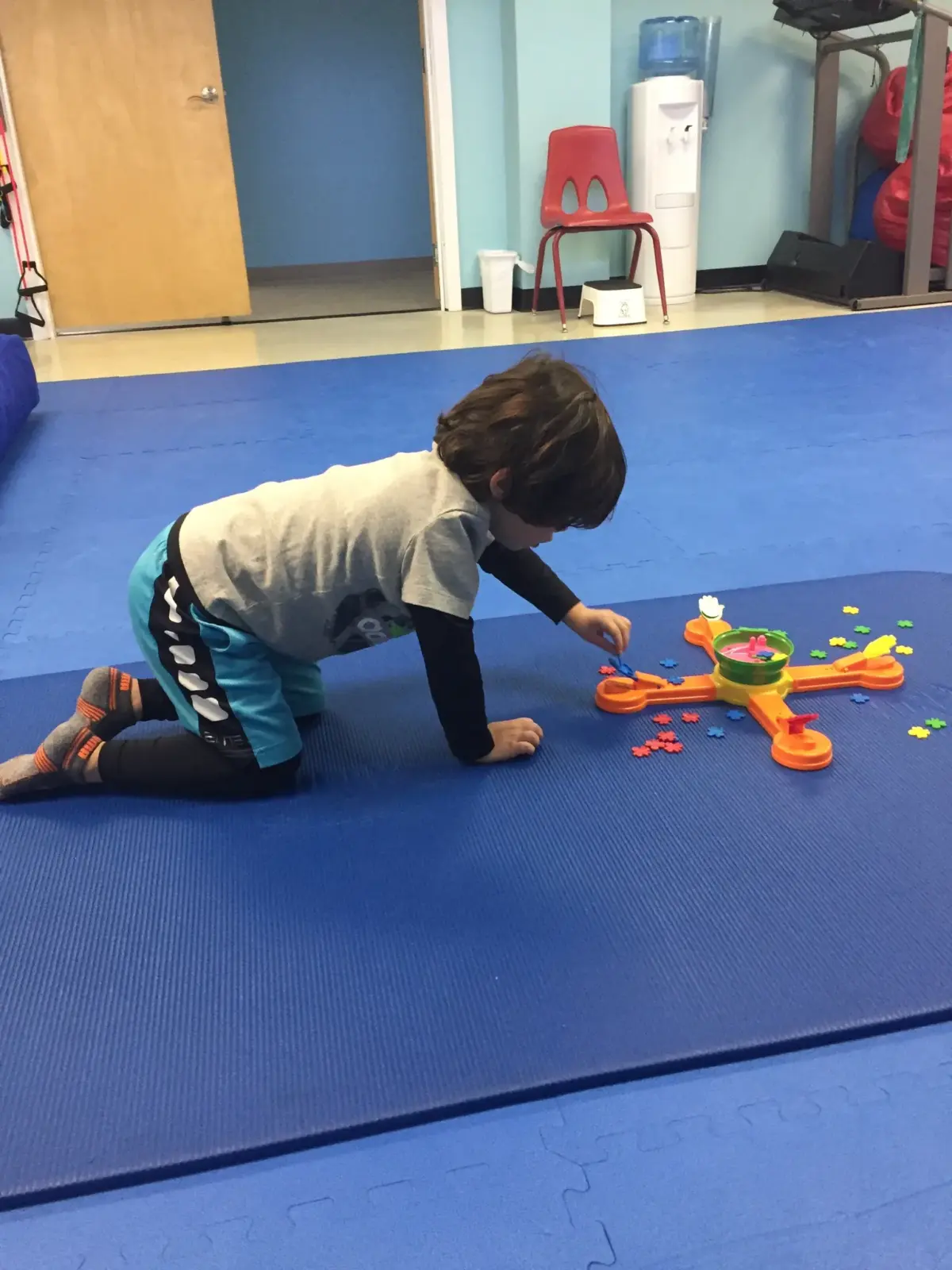Tummy Time for Newborns and Babies: The Do’s and Don’ts
By Dr. Hayley Apiscopa, Pediatric Physical Therapist, Co-Owner Developmental Steps
Are you unsure how to tummy-time your newborn baby? Or how often should it be done? Do you have a baby that hates tummy-time? This article is for you. Today, I will share my tips about tummy-time, including the rules and regulations, so that your baby can have a great time. It is also not stressful for parents.
Hi! My name is Dr. Hayley Apiscopa, Pediatric Physical Therapist and Co-Owner of Developmental Steps. I have had the privilege of working with parents and their children as young as newborns up until high school over the past 19 years. I also have two beautiful children of my own. It was clear to me that the world was overwhelming, and that it made parenting very difficult when I became a mom. I created this blog to share information that was evidence-based, as well as tips and tricks I learned as a pediatric physical therapist. This will make it easier for parents to share the right information with their children and help them get the best start in life.
Before we start with tummy time. Tummy time is when your baby lies on their stomach… plain and simple. It’s vital because it helps to develop their neck, head, and upper body muscles. These muscles are essential for their development as they learn to crawl, sit up, crawl, and roll. It is important to remember that babies often fuss and cry when they are placed on their stomachs. Tummy time is especially important when you are starting. It’s hard work for them. It’s a difficult task for their muscles to lift their heads. They can’t see well and can’t use their hands. Tummy time is essential for your baby’s development and strength. You’ve heard it many times. Your baby will be more comfortable in this position and they will be less fussy during tummy time. They need to be exposed to tummy time as a constant practice because it’s the only way to get stronger. If we do that activity, our muscles will be stronger.
You might be thinking that I have a newborn and they hate it. I have a baby that is one, two, or three months old and they hate tummy time. Today I will share my tips and tricks for tummy-time with you. This will make it a lot more enjoyable for your baby. They will soon enjoy it. They’ll then be more inclined to do this activity. It will also be less stressful for parents. What are your dos and don’ts?
Can I Start Tummy Time Right Away?
Do start tummy time straight away. If your baby is full term and has no medical conditions, you can begin tummy time immediately after you return from the hospital. As a newborn, you want your baby to be in tummy time for no more than one to two minutes before you flip them over onto their back. This will be repeated many times throughout the day. The key word here is “day”.
Can A Baby Sleep On Their Stomach?
Tummy time is not something we do at night. You do it throughout the day. It would be something you do for every hour of the day that your baby is awake. They would then wake up from their nap. They will then have a one- to two-minute tummy time. Then they will go for another nap, then another wake period. You do tummy time once more.
Your baby should be capable of doing an hour of tummy time per day by the age of three months. Remember, this is broken down into smaller pieces. At three months old, I don’t expect a baby to remain in the tummy time position for more than an hour. You are not expecting them to do tummy time six days a week. This is for 5 to 10-minute blocks during the day. Tummy time should be started early so the baby is familiar with it. You can then have them lie on their stomach for a few seconds, and then flip them over onto their back. They’ll be content. It will become a routine for both you and your baby if it is done immediately. It’s okay if you don’t do tummy time at all. Start now.
Tummy time should be done when your baby is awake and alert. We do tummy time during the day. It’s not something we do at night. We also make sure to supervise our babies as they are placed on their stomachs. To ensure they don’t get tired or can’t see clearly, you will be there to help them roll onto their backs if they do. You do this when they are awake and alert.
Another thing I like about it is that I do it after bottles or breastfeeding. Your baby will wake up and you’ll then feed them and change their diaper. After that, they will be happy for a brief period. Tummy time is recommended for those times. Your baby should be happy, not hungry or upset. Your baby may become fussy or clingy around the two-week mark. This is usually around two weeks old. They won’t want to be on the ground for tummy time. Therefore, I prefer to do chest-to-chest stomach time.
What Are The Four Tummy Time Positions?
This brings me to my next tip, which is to ensure you use all the tummy time positions. There are four different tummy times positions:
Traditional Tummy Time Position
Traditional tummy-time is where your baby lies on the ground with their arms under their body. This can be a very difficult tummy time position to start.
Chest-To-Chest Position
The chest-to-chest position is the second tummy-time position. This is when you are lying on a surface with your baby on your chest. They can then look up at you while tummy time is taking place. This allows your baby to strengthen their core and their neck muscles.
Lap Position
The third position is where your baby lies across your lap. The ripples of your legs create a nice unbalanced surface which will help aid in more core stability for your baby.
Boppy Pillow
The final position can be done with your baby laying on a Boppy pillow. Tuck your baby’s forearms underneath their shoulders to allow your baby to lift their head. By using the Boppy pillow, it makes it easier for the baby to lift their head up against gravity. Gradually build up their time on Boppy pillow and you will be amazed at how their tummy time improves.
How To Make Tummy Time Enjoyable For Your Baby?
Next, I recommend that you make tummy time for your baby easier. When your baby is born, their tummy time tends to be very heavy at first. This means that their body weight tends to be heavier towards their head, shoulders, and neck than the rest of their bodies. They can’t lift their heads very high. We can make tummy-time, all the four positions I have shown you, much easier. This is done by supporting them and shifting the weight to their hips, their legs, and their heads so they can lift their heads more easily. Let me show you how to do this in each of the following positions:
You can help your baby in the traditional tummy-time position, where they are flat on the ground, by placing your hand on their hip. This will help shift their weight to their legs. They will be able to lift their heads more easily. You can also place a towel under their arms. This will raise their front end up and make it easier for them to lift their heads.
In the chest-to-chest position. There are a few options for how to place your baby on your chest. The first is that if your baby is lying flat on your chest and you are laying flat on a mattress, then they will have to raise their head against gravity. It’s much more difficult than if you are sitting in a chair. In a chair, Your baby will be able to lift their head easier because the gravity is not as strong. You can also support their hips by placing your hand on their bottom. You can do this by placing your hand on their hips, or their bottom. This will shift their weight to the back of the legs. You can also support their forearms. You can hold their forearms in position. This allows them to place weight through their arms. It also makes it easier to lift their heads.
The other position we discussed was to lay your baby across your legs. This can be made easier for your baby. If your legs are straight, your baby will be able to lift its head against gravity. This position is easier for them. Your baby will be more supported if you place your hand on their bottom. This helps to shift their weight to their legs and makes it easier to raise their heads in this position.
The last position that we discussed is over the Boppy pillow. You can make it easier for your baby by placing your hand on their bottom or hip. You can do this again to shift the weight to their backs, making it easier for them to lift their head while laying on the Boppy pillow.
Can I Use Toys During Tummy Time?
We know that tummy time can be a difficult activity for babies. Parents need to make it enjoyable for their children. Your baby can lose focus on the discomfort and get distracted if you incorporate toys and your singing. They think, “Oh, yes, this is hard but it is fun and enjoyable for me.” There are many ways to make tummy time more fun for your baby.
First, you can sit next to your baby and sing a song while they do traditional tummy time. Because they only have a brief period of happiness in this position before they get fussy, it’s best to do it while your baby is still a newborn. Then I turn them over to their back for a little rest before we go back into tummy time. As they become stronger in this position I continue to sing and then flip and then repeat.
You can also place a non-breakable mirror in front of their faces so that they can see their faces when they raise their heads. Babies love seeing faces. This is another way to entertain your baby. 
You can also use a musical or light-up toy to motivate your baby to lift their head. Remember that babies can see color. High-contrast toys are what babies love the most at this age. They can see well from 8 inches. You place the toy between 8 and 20 inches from their eyes. They will look at the toy when they raise their heads. You could also place a brightly colored book on their head, or read to them while they are in this position. Make it fun and quick so they have fun.
Where Should I Perform Tummy Time?
The last thing that you can do is to try tummy time at different locations in your house. Instead of having tummy time in the same spot with the same toys all the time, your baby can have tummy time looking out the window for example. This is where they can see the birds, the trees, and pets. It makes tummy-time a little more fun for our babies.
The only thing I don’t recommend is to stop your baby from having tummy time. All babies don’t like tummy-time. Because it’s so difficult, babies will cry and fuss if they are placed in tummy-time. It is possible to make it easier for your babies if you do it throughout the day and for a brief burst. It should only be done for a brief time. If your baby doesn’t like it, then you can make sure they are happy before flipping them on their back. You can increase the time they spend in tummy time as they grow stronger.
Remember the four positions for tummy-time. You might not like the traditional tummy time with your baby, but you have three options and can grade them. They’re much more manageable. To help them shift their body weight from their legs to their bottom, you might be able to provide support. It’s much easier to raise their heads. Roll-up towels are an option. Your leg could be lifted. You can make it easier for your baby to eat in the beginning. As they grow stronger, you can gradually reduce the amount of support you give them. Your baby will grow stronger if you continue to give them tummy time. Make it fun and short. The baby will be in the same position for longer which is a great thing.
What Happens If You Forget To Do Tummy Time?
Don’t worry if your tummy time is not completed that day. It’s okay. It is okay to have days that are not so great. You might find your baby fussy or clingy one day, but you won’t be able to get to tummy time the next. Fine. Tomorrow is a new day. Your baby will be more comfortable in tummy time if they practice it. As they grow stronger, they’ll become less fussy and start to like this position. Remember these four tummy-time positions, and tummy times will become easier for both you and your baby.
This is it, Moms and dads. Here are my guidelines for tummy-time. I hope that tummy time will be a more enjoyable activity for you and your baby. Keep in mind the four different tummy times positions. It doesn’t necessarily have to be the traditional tummy time. Keep those four things in mind and use them throughout the day. You will find the one your baby likes and you can continue doing so until your baby is strong in that position. They also allow me to tolerate the traditional tummy-time on the floor.













